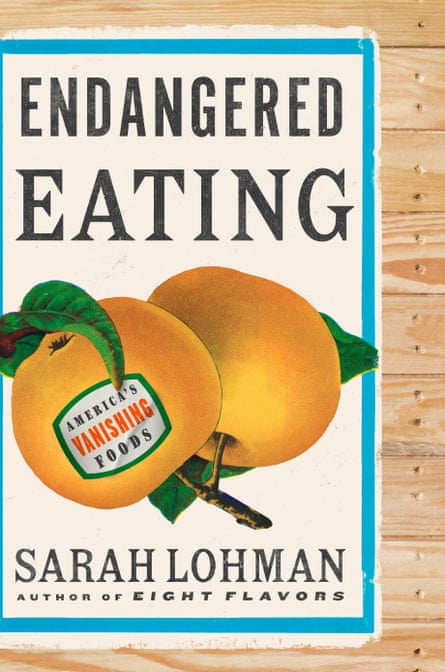The American buff goose. Amish deer tongue lettuce. The Nancy Hall sweet potato. The mulefoot hog. When food historian Sarah Lohman stumbled on these fantastical-sounding ingredients in a database of vanishing foods called the Ark of Taste, she set off on a journey across the United States to discover more ingredients and traditions that had been abandoned in the annals of history.
The endeavor was the latest installment of a storied career that has included cooking 19th-century recipes at a living history museum and chronicling American cuisine in her book Eight Flavors, which documents how foods like black pepper and sriracha have helped reshape what Americans eat.

Her journey across the United States resulted in her latest book, Endangered Eating: America’s Vanishing Foods, which came out in October. To report the book, she clambered up ladders in Coachella valley to examine rare dates dangling from palm trees. She butchered and prepared a Navajo-churro sheep with local people living on Indigenous land in the south-west. She flew to South Carolina to visit a farm where a food historian was growing a type of peanut previously thought to be extinct.
Lohman spoke to the Guardian about the cultural and political importance of these near-forgotten foods. This interview has been edited for length and clarity.
So what is an endangered food, exactly?
I was drawn into this whole project because endangered foods are not something we usually think about. Usually, the term is applied to species: manatees, or pandas. People don’t say, “Save the Long Island cheese pumpkin,” which is a beautiful native Long Island pumpkin that is also on the Ark of Taste list [which is run by the NGO Slow Food International].
But endangered foods are the focus of Slow Food International’s work. They catalogue thousands of international and hundreds of national foods that are considered delicious, distinctive and worthy of protection. In some cases, those foods are not endangered, just hyperlocal, and they want to protect that food because it’s important culturally in some way. In other cases, there’s a threat to the foods they’ve catalogued: there are few of them left or there’s a reason they’re not grown anymore. One theme in my book is that there’s a very diverse list of reasons why these foods are on the brink of extinction. Some are stable, meaning they’re not imminently going extinct – but stable doesn’t necessarily mean safe.
What might land a food on the endangered list?
It depends. For Coachella valley dates, the biggest reason is that farming is a difficult industry. The second- and third-generation inheritors of a family farm don’t necessarily want to keep going, so those plants can be lost. For Hawaiian legacy sugar cane, development played a huge role. Hawaiian resorts have a huge effect on native and agricultural plants, as people’s homes are being bought up and their backyards bulldozed. The endangerment of the Navajo-churro sheep and other Indigenous foods are the results of colonization and cultural genocide. This happens when Indigenous people are moved off their land and then [their foods are] purposely replaced with foods that are important to European Americans, such as white flour, pork and coffee. That’s the government coming in and saying: “That’s not the right way to live. Empty space is unused space. You need to plant a tree on it. You can’t move around with your herds.”
It can also be something simple. The Carolina runner peanut is a little tiny peanut that’s delicious but hard to pick by hand, and was discarded for a larger peanut that fits machinery better. There are so many reasons. You can see how they create a broad picture of American history and all the ways we’ve chosen to shape our landscape over time. It’s time to walk some of that back to make sure we can maintain that culinary history.
And why is that culinary history important? Why preserve these foods?
It depends who you ask. For me, individual foods are important because they’re culturally important. Flavor is processed in the same part of the brain as memory. We often talk about the taste of home, whether that’s your family’s cooking or a food that’s only available in the geographical region where you grew up. Imagine that flavor being taken away and never experiencing it again. There’s something deeply psychologically important about these foods sticking around. Also, as I wrote in this book, it’s important to assist cultures across America, whether that’s native, Black, migrant or immigrant groups, to make sure that everybody has access to their particular cultural foods, and that the caretakers of those foods will have them for a long time to come.
In 2016, I reviewed your previous book, Eight Flavors, which argued that American cuisine is constantly expanding to encompass new food traditions. Did your latest research inspire you to question or expand upon that thesis?

Of course, in Eight Flavors, I thought about some of these ideas. That book is also concerned with the idea of what we eat and why: this is why we’re eating black pepper, this is where vanilla came from. In Eight Flavors, I explore the idea that American food comes here in shifts. I still enjoy seeing that play out.
But at the same time, there’s this list of hundreds of things that have been edited out of our food systems. This book asks the question: why? What is it saying about us that we are selecting out foods we don’t eat? Where are those foods going? A lot of times, it’s not easy to make sure they’re preserved, but it’s incredibly worthwhile.
What’s your favorite of the foods you explore in this book?
There’s an apple called the Newtown pippin, which was created on Long Island. Nobody is familiar with this apple anymore, but it’s never faced the same endangerment as other heirloom apples because it’s the primary apple in Martinelli’s cider. They pay a premium for Newtown pippin to be planted. That’s very nostalgic for me, because Martinelli’s was a big part of my family.
Now, instead of thinking about something as an apple, I think about the story behind it. I see these ingredients everywhere now. It feels like learning a new language.
I love that feeling when you’re introduced to a different way of noticing. It’s like putting on a new lens.
That’s the hope for this book: that it’ll change the ways that readers look at American food, and everything that food can mean.
Once people put on that lens, what definitive steps can they take to save these foods? What’s the solution here?
I don’t think there’s any one answer. One major question we need to consider is: who should have access to these foods and at what price? I found people profiting off Indigenous foods, and other people profiting off Black American foodways, who weren’t of that culture and weren’t doing much to provide money or support the original caretakers of these plants. We should view saving foods as an opportunity for people with money and power to funnel money to other people who don’t have it. For example, it can mean buying real wild rice from the Ojibwe tribe in the American midwest [who’ve cultivated wild rice for thousands of years]. It doesn’t only put money into the tribal nation, but also to individuals who harvested that rice and sold it. It’s a real investment in the community. It can be that easy to buy a bag of rice.
Also, if you’re traveling, you can make an effort to engage with the local food community. I use the Ark of Taste book as a food guide. For example, people go to the Coachella valley all the time, for vacation in Palm Springs or to the music festival. If you’re there, why not go to the date farm and try some dates? You’ll put money into the pocket of the farmer and get to taste one of the world’s most delicious foods. You can also let the book guide you to something that’s 30 minutes away from you. These foods are an invitation to learn something about your own region, your own culture. They can also give you the incredible opportunity to learn about somebody else.
"ingredients" - Google News
November 05, 2023 at 07:00PM
https://ift.tt/ZA4OLg6
‘On the brink of extinction’: a food historian’s hunt for ingredients vanishing from US plates - The Guardian
"ingredients" - Google News
https://ift.tt/3EFNAsi
Shoes Man Tutorial
Pos News Update
Meme Update
Korean Entertainment News
Japan News Update
Bagikan Berita Ini














0 Response to "‘On the brink of extinction’: a food historian’s hunt for ingredients vanishing from US plates - The Guardian"
Post a Comment